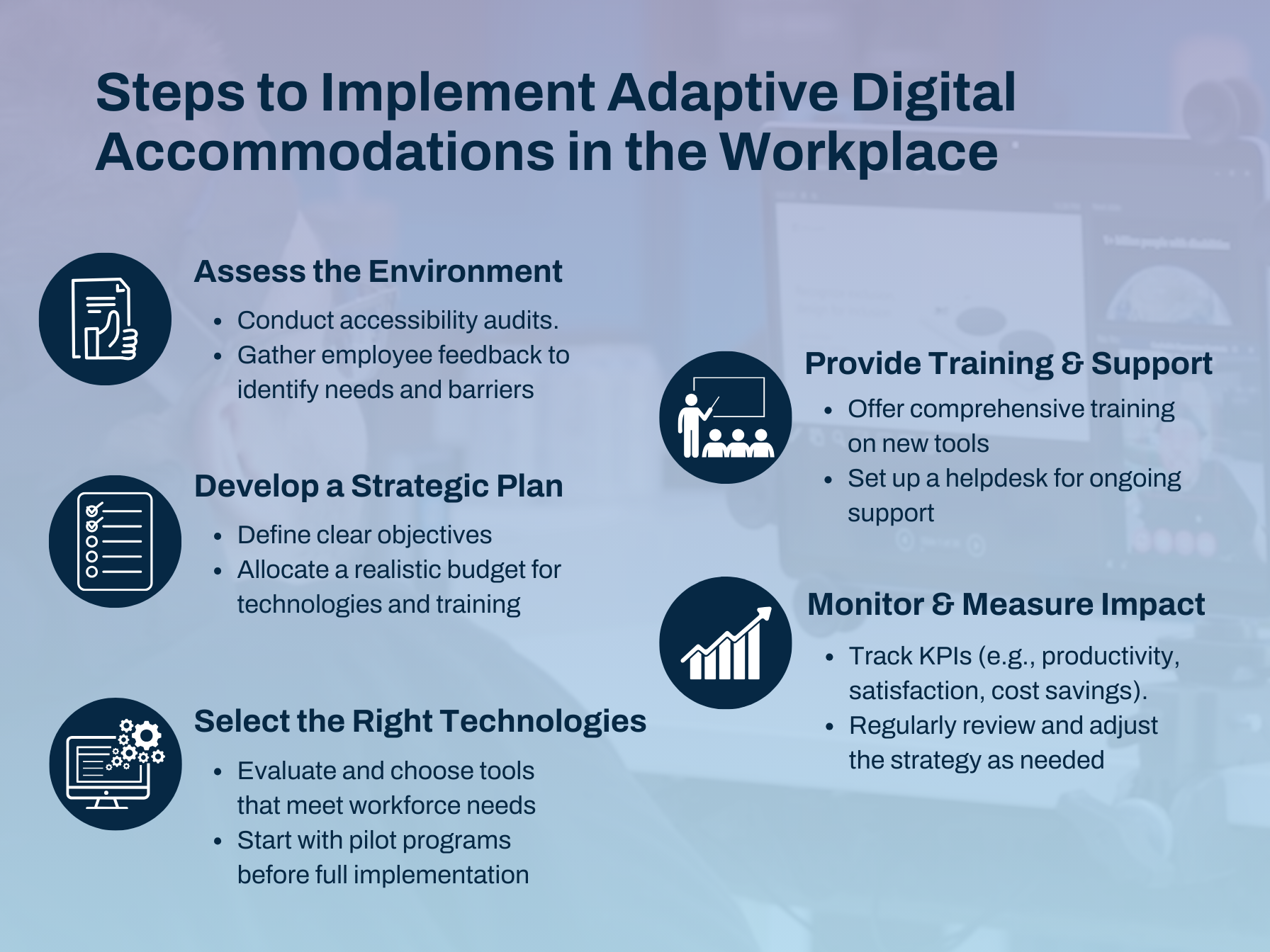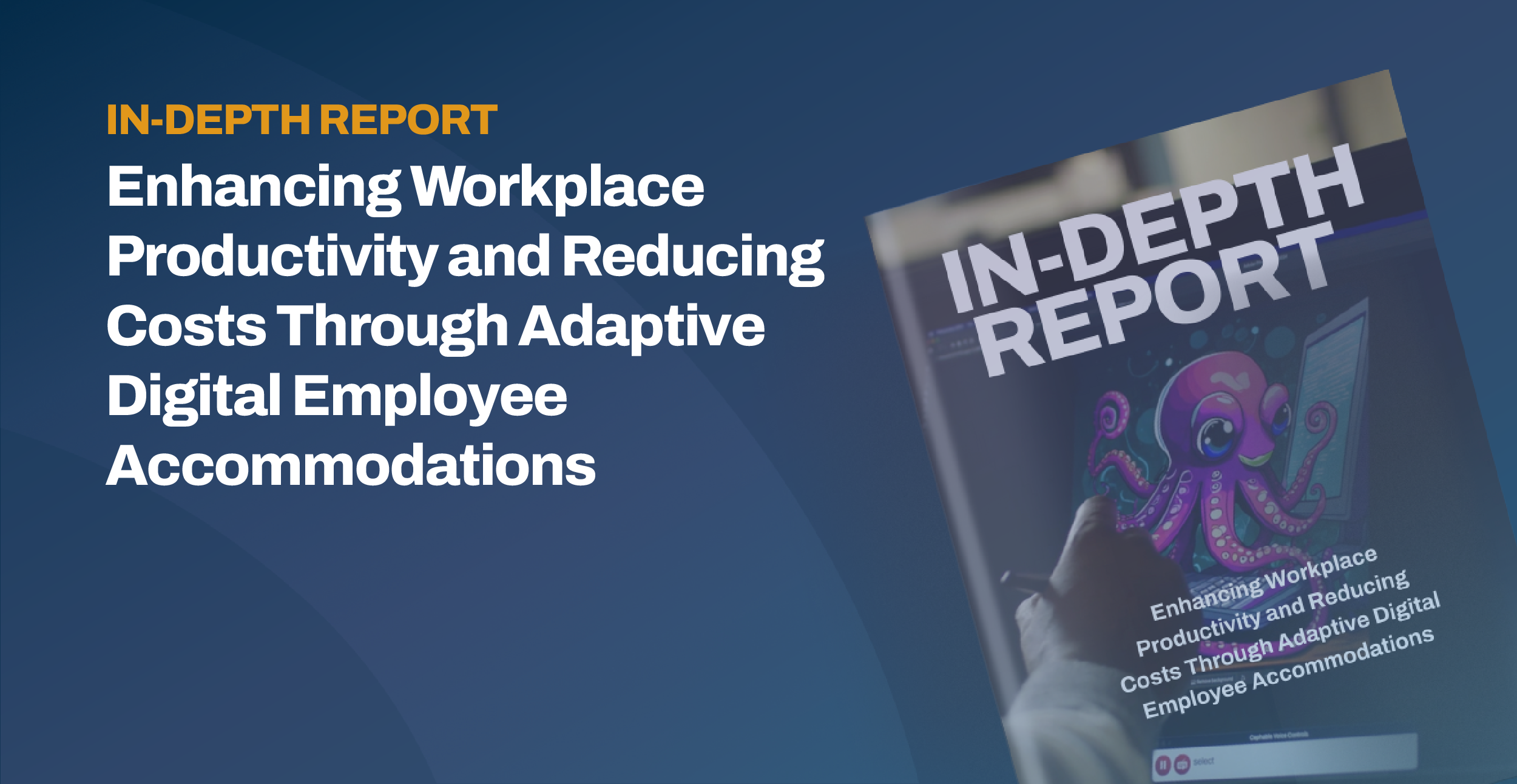Executive Summary
In today’s diverse workforce, the importance of inclusivity and accessibility cannot be overstated. This report delves into how adaptive digital employee accommodations can significantly enhance workplace productivity and reduce costs. By leveraging these technologies, companies not only fulfill their legal obligations but also unlock the full potential of their employees, leading to a more engaged workforce and a stronger bottom line. The following sections will provide a detailed exploration of the benefits of accessibility technology, along with a step-by-step guide for its effective implementation.
Introduction
As workplaces evolve, creating environments that accommodate all employees, regardless of their abilities, becomes increasingly critical. Adaptive digital accommodations—technologies specifically designed to assist individuals with disabilities—play a pivotal role in this endeavor. These technologies range from simple tools like screen readers to more complex systems like voice recognition software. This report will provide an in-depth analysis of these tools, illustrating how their integration can lead to substantial gains in productivity and significant cost savings for businesses. Additionally, it will offer a practical, step-by-step guide for companies looking to implement these technologies effectively.
1. Understanding Adaptive Digital Employee Accommodations
Adaptive digital employee accommodations refer to a variety of tools and technologies designed to assist employees with disabilities in performing their job tasks more efficiently. These accommodations can include everything from software that converts spoken words into text, to devices that allow for alternative input methods, such as head movements or eye-tracking. The scope of these technologies is broad, but their purpose is singular: to create an inclusive work environment where all employees can contribute fully.
Beyond the practical benefits, the implementation of these technologies is often a legal requirement under laws such as the Americans with Disabilities Act (ADA). The ADA mandates that employers provide reasonable accommodations to qualified individuals with disabilities, ensuring they have the same opportunities as their non-disabled peers. However, the impact of these accommodations goes beyond compliance. Companies that prioritize accessibility not only adhere to legal standards but also demonstrate a commitment to corporate social responsibility (CSR). By fostering an inclusive workplace, they enhance their reputation, attract diverse talent, and position themselves as leaders in diversity and inclusion.
2. The Business Case for Adaptive Digital Accommodations
Investing in adaptive digital accommodations is not just a moral or legal obligation—it makes sound business sense. One of the most immediate benefits is an increase in employee productivity. When employees have the tools they need to perform their jobs effectively, they are more engaged, less frustrated, and more motivated to contribute to the organization’s goals. This boost in engagement directly correlates with higher productivity levels, as employees can complete their tasks more efficiently and with greater accuracy.
Moreover, companies that provide appropriate accommodations tend to have lower turnover rates. Employees who feel supported and valued are more likely to remain with their employer, reducing the costs associated with recruiting and training new hires. In this way, adaptive technologies help retain valuable talent, further enhancing productivity and organizational stability.
From a cost perspective, the benefits of adaptive accommodations extend beyond retention. By reducing absenteeism—often a result of employees struggling to work in an environment that does not meet their needs—companies can save significantly. Additionally, the investment in assistive technologies can reduce the need for extensive training programs for new employees, as the tools enable employees with disabilities to perform at their best from the outset.
Furthermore, companies that prioritize accessibility gain a competitive advantage. Inclusive workplaces are more likely to attract a diverse workforce, bringing in a wide range of perspectives that can drive innovation. This diversity is not only beneficial internally but also helps differentiate a company in the marketplace, appealing to customers who value inclusivity and social responsibility.
3. Step-by-Step Guide to Implementing Adaptive Digital Accommodations

Implementing adaptive digital accommodations in the workplace requires a strategic and well-planned approach. The first step is to assess the current workplace environment to identify areas where accessibility can be improved. This assessment can be conducted through accessibility audits, which help pinpoint barriers that may hinder employees with disabilities. Gathering feedback directly from employees is also crucial, as they can provide insights into their specific needs and preferences.
Once the assessment is complete, the next step is to develop a comprehensive plan that outlines the goals of the accessibility initiatives. This plan should include clear objectives, such as improving employee productivity or reducing turnover, and should be backed by a realistic budget allocation. Ensuring that sufficient funds are available for purchasing necessary technologies and providing training is essential for the success of the initiative.
Selecting the right technologies is a critical part of this process. Companies should carefully evaluate various solutions to determine which tools best meet the needs of their workforce. This might include software like Cephable, which offers voice and gesture-based controls, or other assistive devices tailored to specific disabilities. To minimize risks and ensure a smooth transition, it’s advisable to start with pilot programs, where a small group of employees tests the new technologies before a full-scale rollout.
Training and support are key to the successful adoption of these technologies. Employees need to be adequately trained to use the new tools effectively, and ongoing support should be available to address any issues that arise. Establishing a dedicated helpdesk or support team can help ensure that employees have the resources they need to make the most of the accommodations.
Finally, it’s important to monitor and measure the impact of the accommodations. Companies should track key performance indicators (KPIs) such as productivity levels, employee satisfaction, and cost savings to evaluate the effectiveness of the accommodations. Regular reviews should be conducted to assess progress and make any necessary adjustments to the strategy.

